
PREFABRICATED STRUCTURE CONSTRUCTION SERVICES
Prefabricated Structure Construction - Estimation Per Sq ft
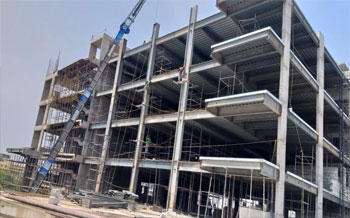
Client: Icon Commercial Complex, Hosur
Length: 150 feet
Width: 300 feet
Height: 32 feet
Total Area: 45,000 Sq. feet
Types of Material Used: PEB Steel Frame, JSW Roofing Sheet (0.47 mm Thickness), RCC Foundation, Galvalume Purlins
Learn More
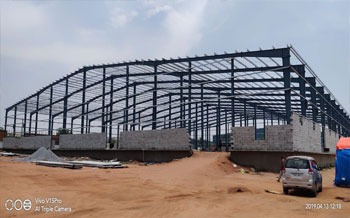
Client: GK Reality, Oragadam
Length: 120 feet
Width: 250 feet
Height: 28 feet
Total Area: 30,000 Sq. feet
Types of Material Used: Prefabricated Steel Frame, TATA BlueScope Roofing (0.50 mm), Concrete Flooring, Structural Beams
Learn More
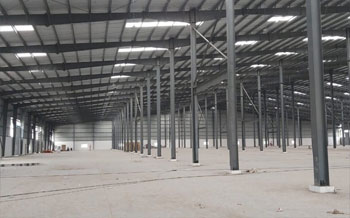
Client: MR Protech, Bangalore
Length: 180 feet
Width: 320 feet
Height: 35 feet
Total Area: 57,600 Sq. feet
Types of Material Used: PEB Structure, AMNS Galvanized Sheet (0.45 mm), Steel Column, Fibre Reinforced Panels
Learn More
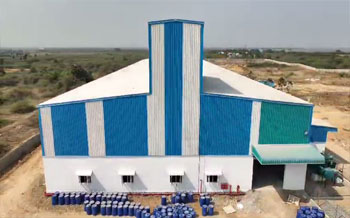
Client: RMG Polyvinyl India Ltd, Cheyyar
Length: 140 feet
Width: 280 feet
Height: 30 feet
Total Area: 39,200 Sq. feet
Types of Material Used: Prefab Frame, Essar Colour Coated Roofing (0.50 mm), Reinforced Concrete, Structural Steel
Learn More
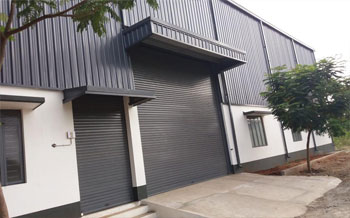
Client: Aero Pistons, Ambattur
Length: 160 feet
Width: 340 feet
Height: 33 feet
Total Area: 54,400 Sq. feet
Types of Material Used: Heavy Steel Frame, JSW Colour Coated Sheet (0.47 mm), Concrete Base, PEB Rafter & Purlin
Learn More
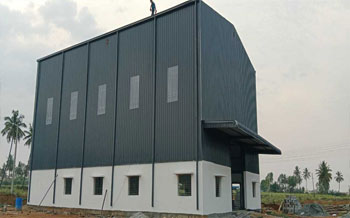
Client: Hibrow Healthcare Pvt Ltd, Mamandur
Length: 110 feet
Width: 240 feet
Height: 26 feet
Total Area: 26,400 Sq. feet
Types of Material Used: Modular Prefabricated Frame, TATA Roofing Sheet (0.50 mm), RCC Flooring, Galvanized Steel Members
Learn More
Prefabricated Structures

Prefabricated Structures
Prefabricated structures are buildings that are made in a factory away from the construction site and then moved to the location for assembly. This approach is generally quicker and often more economical than conventional construction, as the components are produced at the same time as the site is being prepared. The main benefits include speed, minimized waste, and uniform quality due to the regulated conditions of the factory, making them ideal for a range of applications from temporary setups to permanent residences and commercial properties.
Prefabricated Buildings
Prefabricated buildings are created in a factory using pre-manufactured sections or modules, which are then assembled at the final location, a process referred to as off-site or modular construction. This technique facilitates quicker building, enhanced quality control, decreased waste, and improved cost efficiency compared to traditional on-site construction. These structures can be tailored for various purposes, including homes, offices, schools, and hospitals.
Prefab Building Contractors
Prefab building contractors are responsible for constructing buildings with prefabricated elements that are produced in a factory and then assembled on-site. This approach not only saves time and money compared to traditional construction methods but also enhances quality control and reduces waste. These contractors work on a diverse range of structures, from residential homes to commercial and industrial buildings, utilizing materials such as steel, concrete, and wood.
Key aspects of prefab building contractors
Off-site manufacturing: Components are produced in a controlled factory setting, resulting in superior quality and less waste.
On-site assembly: The prefabricated parts are delivered to the construction site for quick assembly, which shortens the overall project duration.
Cost and time savings: The regulated factory environment and expedited assembly process contribute to substantial savings in both time and expenses.
Quality control: Constructing in a factory setting enables consistent quality assurance and comprehensive inspections at every phase.
Sustainability: This approach is more environmentally friendly due to minimized waste, efficient material usage, and the possibility of incorporating recycled materials.
Material options: Prefabricated buildings can be made from a diverse range of materials, such as steel, concrete, and wood, tailored to the specific requirements and budget of the project.
Durability and safety: These constructions are designed to comply with building regulations and are engineered for durability and resistance to weather conditions.
Versatility: Contractors can create a variety of structures, including residential homes, modular offices, commercial buildings, and industrial warehouses.
Relocatability: Certain prefabricated structures can be taken apart and moved to a new location.
Prefabricated Structure Manufacturers
Prefabricated Structures, often referred to as off-site construction, involve the production of building components or entire buildings in a controlled factory setting before they are transported to the construction site for assembly. This method contrasts with traditional on-site construction, where materials are delivered to the site and assembled incrementally. The benefits of prefabrication are numerous, providing improved efficiency, cost savings, and sustainability while addressing many issues linked to conventional construction methods.
In recent years, the construction sector in India has experienced a notable transition towards innovative and efficient building techniques. Among these, prefabricated structures have proven to be transformative, presenting various advantages over traditional construction practices. As urbanization speeds up and the need for infrastructure and housing increases, prefabricated structures offer an attractive solution for developers and contractors in India. This blog delves into the emergence of prefabricated structures in construction, their benefits, cost considerations, and their significance in the Indian market, along with some prominent examples.
Prefab Structure Suppliers
Prefab structure suppliers offer prefabricated building elements, such as roofs and flooring, which are produced off-site in a factory and subsequently transported to the construction site for final assembly. This method, referred to as prefabrication, is utilized to construct buildings for various purposes, including residential, commercial, and industrial facilities, providing benefits such as expedited construction, cost reduction, and enhanced quality control.
What prefab structure suppliers do
Manufacture components: They produce the different parts of a structure in a controlled factory setting, which decreases on-site waste and mitigates weather-related delays.
Use diverse materials: Suppliers utilize a variety of materials, including steel, concrete, wood, and plastic, to construct robust and high-quality structures.
Offer custom solutions: Numerous suppliers deliver tailored solutions to meet specific requirements, such as pre-engineered buildings for factories, modular options for smart homes, or specialized structures like cold storage facilities or watchtowers.
Deliver for assembly: The finished components are sent to the construction site for swift and efficient assembly, whether they are fully or partially pre-assembled.
Ensure quality: Constructing in a controlled factory environment results in superior quality control and precision, with fewer human errors compared to conventional construction.
Prefab Construction Companies
Prefabricated (prefab) construction companies manufacture buildings in a factory using pre-assembled components like walls, floors, and modules, which are then delivered to a site for assembly. This off-site construction approach provides quicker project timelines, cost savings through enhanced efficiency, improved quality control, and minimized waste. Prefabrication can be applied to a broad spectrum of projects, encompassing residential, commercial, and industrial buildings, utilizing materials such as steel, concrete, and wood.
Prefabricated Steel Structures
Prefabricated steel structures are buildings made from standardized steel frame components, which include columns, beams, purlins (for walls and roofs), galvanized steel sheets for both walls and roofs, and various accessories (such as trim, gutters, galvanized steel bracing cables, roof ridge vents, etc.). These components are manufactured and assembled according to technical design specifications.
The entire process of creating prefabricated steel structures, from design and fabrication to transportation and installation, is executed at remarkably fast speeds. Additionally, these buildings enable investors to optimize the use of interior space by utilizing clear-span frames that can reach widths of up to 180m (PEB Steel frame). If design modifications or expansions are necessary, investors can implement them easily with prefabricated steel structures without significantly impacting the main framework, thus reducing implementation costs compared to conventional construction methods.
Prefabricated steel structures possess excellent load-bearing capabilities and are lighter than reinforced concrete buildings, which helps to lessen the load on foundations. Consequently, investors can reduce expenses related to foundation reinforcement, construction materials, and labor. These structures are frequently employed in various projects, including exhibition halls, shopping centers, cinemas, supermarkets, training centers, conference centers, multipurpose halls, hotels/resorts/restaurants, offices, sports facilities, parking areas, and public amenities (such as schools, hospitals, churches, temples, museums, exhibition halls, courts, etc.)
Prefabricated Warehouse Buildings
A prefabricated warehouse can significantly enhance your storage capacity without the expenses, disruptions, and time delays typically associated with conventional construction methods. A prefabricated building, often called a prefab, is a sturdy structure manufactured off-site, usually in a factory setting. Once the components are produced, they are transported to the site for assembly.
This approach minimizes disruption, downtime, and project timelines while ensuring quality control at every stage of the manufacturing process. Ultimately, this results in a high-quality storage building that is suitable for a variety of storage applications. One of the standout features of prefabricated warehouse buildings is their flexibility. We utilize a durable aluminum frame that ensures optimal longevity. A key distinction between a steel warehouse building and our prefabricated solution lies in the frame material.
Thanks to the aluminum frame, if your storage needs evolve, you can easily extend your warehouse or relocate it to a different site. Furthermore, if you need to downsize your storage, you can sell the structure in the second-hand market. Acquiring a prefabricated warehouse offers similar flexibility, with various options available for hiring, financing, or outright purchasing the structure. This provides a unique level of adaptability for growing businesses to adjust and evolve without incurring significant upfront costs.
Prefab Industrial Sheds
Prefab industrial sheds are constructed off-site using high-quality materials and modern technology. They are then transported to the site for rapid assembly. This method differs from traditional sheds, resulting in less site work and lower costs. These sheds feature insulated panels and sanitary fittings, making them suitable for various industries. They are versatile and can accommodate different client requirements. Prefab metal sheds are robust and resistant to rust, making them a wise investment for businesses. As the demand for efficient and environmentally friendly buildings increases, these sheds are poised to represent the future of construction.
One significant benefit of prefab sheds is their rapid installation. This allows businesses to commence operations sooner. Crafted with precision, quality, and consistency, these structures are made from mild steel and PPGI sheets, ensuring durability. They require minimal maintenance, which helps businesses reduce costs. This is an intelligent approach to resource optimization. These sheds can be tailored for various industries, including warehouses, workshops, factories, and more. Equipped with insulated panels and sanitary fittings, they are both comfortable and functional. As companies seek innovative and eco-friendly solutions, prefab sheds emerge as the ideal choice. They are the preferred option for maintaining competitiveness in the current market.
Prefab Factory Buildings
Prefabricated factory buildings rank among the most in-demand products within the modular building sector. Also referred to as pre-engineered steel sheds, these versatile structures serve multiple purposes. They are essential for factory sheds, warehouses, agricultural constructions, poultry facilities, and much more. How do they differ from traditional factory constructions? The differences are numerous. These factory buildings require less maintenance, can be transported more quickly, facilitate easier development, and can endure harsh weather conditions. It is advisable to choose one of the leading companies for purchasing a prefabricated factory building. Let’s explore factory buildings in greater detail.
Regardless of the material you choose, offsite prefabrication necessitates minimal maintenance on the exterior. In contrast to conventional constructions that require repainting every few years, high-quality products feature pre-painted galvanized sheets on the exterior. This paint lasts for many years. If your prefab factory building is made of steel, there is no risk of damage from termites. Additionally, since steel is an inorganic metal, it prevents the growth of mold, mildew, or other fungi.
The durability of prefab steel sheds presents an attractive option for business owners. Steel is long-lasting and can withstand harsh and challenging weather conditions. Pre-engineered factory buildings can endure for many years with minimal maintenance. Additionally, pre-engineered steel structures are fire-resistant, eliminating concerns about fire damage.
Prefabricated Office Buildings
In simple terms, a prefabricated office is a structure that is produced and assembled using prefabrication techniques. It comprises factory-made structural components or units that are delivered and put together on-site to create the complete construction.
Prefabricated office buildings are assembled on-site by skilled teams. Every aspect of these buildings is managed by our expert teams following the phases outlined in the project, tailored to meet your specific requirements. Both temporary and permanent offices are highly cost-effective due to their short manufacturing time and ease of relocation.
When flexibility and cost-efficiency are your priorities, prefabricated office buildings offer an excellent solution. You can select from a variety of available floor plans or customize your own to suit your worksite.
A prefabricated office building provides an effective solution for commercial office needs. Each modular office features its own distinct design elements, and you will collaborate with our experienced team to create a facility that meets those requirements. These modular office buildings are designed to accommodate a large workforce, necessitating efficiency, durability, and safety.
Prefab Site Office Cabins
Prefab site office cabins, also referred to as prefab cabins, are modular units produced off-site in a controlled setting and assembled at the chosen location. These cabins are intended to function as complete office spaces, providing design, size, and layout flexibility. They can be built using materials like PUF (Polyurethane Foam) panels, MS (Mild Steel), or even repurposed containers, depending on specific requirements.
Key Features of Prefab Site Office Cabins
Customizability: Prefab site office cabins can be adjusted to suit your specific requirements. Whether you need particular dimensions, colors, or specifications, these cabins can be tailored to integrate smoothly into your operations.
Quick Installation: In contrast to conventional construction, which may take several months, prefab cabins are ready for use in just weeks. Their modular design facilitates rapid assembly, reducing downtime.
Portability: These cabins are crafted for easy relocation, making them perfect for businesses that often shift project sites.
Durability: Constructed with premium materials such as PUF and MS, prefab cabins are robust and long-lasting, able to endure various weather conditions.
Cost-Effective: Prefab site office cabins are considerably more economical than traditional construction methods, providing excellent value for money without sacrificing quality.
Prefabricated School Buildings
Prefabricated school buildings represent contemporary educational facilities that are completely manufactured off-site in a controlled factory setting and subsequently transported to the intended location for assembly. These structures utilize modular construction techniques, enabling rapid deployment, cost-effectiveness, and scalability.
Prefabricated school buildings offer a smart solution for creating efficient and budget-friendly educational spaces. These structures are composed of components manufactured in a factory and then delivered to the site for assembly. This method conserves time and labor while ensuring high quality. They can accommodate various types of educational institutions, from primary schools to universities, and can be customized for diverse needs such as classrooms, offices, laboratories, libraries, and recreational spaces. Globally, these buildings are gaining popularity as they can swiftly provide classrooms in areas impacted by disasters or in rapidly expanding urban areas.
As building technology advances, prefabricated school structures are expected to significantly influence the future of education by providing contemporary designs and sustainable solutions that cater to the learning requirements of today. These prefabricated school buildings serve as optimal solutions for rapidly increasing populations, disaster recovery, or temporary educational demands, delivering high-quality learning environments without the lengthy delays associated with traditional construction.
Prefab Hospitals
The continuously changing dynamics of hospitals necessitate modern and efficient solutions to address the growing complexity and demands of patient care. Prefabricated medical facilities represent a new alternative for establishing resilient, future-ready hospital environments that prioritize a patient-first approach, focusing on operational efficiency and the ability to quickly adapt to the changing landscape.
The urgency for rapid construction in hospitals is critical, as delays can affect access to vital services. Conventional construction methods are frequently time-intensive, requiring significant on-site work that can be obstructed by environmental factors, resource availability, or labor shortages. In contrast, prefabricated hospital construction enables off-site manufacturing of Light Gauge Steel Frame (LGSF) and modular hospital buildings, which can then be assembled on-site in a fraction of the time compared to traditional buildings.
A key benefit of prefabricated hospital solutions is the capacity to customize and adjust designs based on specific needs. Each hospital facility has distinct requirements, ranging from operating theatres to specialized patient wards, each with varying spatial and operational demands. Modular hospital designs facilitate customizations, allowing healthcare providers to expand or modify facilities as demand increases or needs evolve.
We are engineered to create comfortable environments using advanced insulation techniques, which are essential for both patient recovery and the well-being of staff. Effective insulation plays a significant role in energy savings, thereby minimizing the environmental impact associated with heating and cooling hospital facilities. Furthermore, energy-efficient designs in prefabricated hospital buildings support sustainability initiatives, aligning with global standards aimed at reducing energy consumption in healthcare settings.
Prefab Residential Buildings
Prefabricated (prefab) residential buildings are constructed from components that are manufactured in a factory and then assembled on-site. This approach utilizes the same materials as conventional homes but provides benefits such as quicker construction, less waste, consistent quality, and minimal disruption to the site. Various types are available, including modular and kit homes, with quality differing based on the manufacturer and design.
Modular Prefab Structures
Prefabricated modular construction represents an innovative approach to building, where structures are assembled under controlled factory conditions. Once the modules are completed, they are transported to the construction site and placed on a prepared foundation. Subsequently, finishing touches are applied. Prefabrication has emerged as a promising construction method and is gaining traction within the industry. The government acknowledges the advantages of this building technique and is actively endorsing it as a solution for producing affordable housing. The time-saving benefits of modular construction are widely recognized.
A modular prefab hospital can be integrated into an existing medical facility. These types of buildings can be operational within a few weeks. Additionally, they can be easily disassembled and relocated to another site for further use or resale once the initial need has been fulfilled. Time is critical during emergencies, such as the recent COVID-19 pandemic, and modular buildings can assist in the recovery of up to one million individuals.
Pre-Engineered Buildings
Recently, pre-engineered buildings (PEBs) have gained popularity. They represent a highly efficient construction approach, offering a refreshing alternative in our rapidly changing world. PEBs are constructed off-site and then assembled at the intended location. Steel is the primary material used in their construction. This innovative method ensures cost savings, quick assembly, and adaptable designs. Additionally, PEBs can be extensively customized to meet the specific needs of clients.
Globally, PEBs are recognized for their durability, as well as their resistance to water and earthquakes. You can expect versatile PEBs that are easy to set up, expand, modify, and transport to meet all your needs. KPGE produces both C and Z purlins, which are also referred to as cold-formed or roll-formed structural steel sections. In today’s fast-paced environment, C and Z steel purlins are ideal for the rapid construction of industrial steel buildings.
In the previous section, we discussed the concept of PEBs. Now, we will delve deeper into their understanding. PEB structures are produced in a factory setting, facilitating quick assembly on-site. The manufacturing process primarily utilizes steel components. PEB buildings offer a high degree of customization, allowing you to create structures that align with your specific requirements and preferences. Furthermore, they possess significant aesthetic appeal.
Pre-Engineered Structure Manufacturers
In today's fast-paced world, the execution speed of construction projects must also accelerate, becoming smarter and more budget-friendly. Pre-engineered building solutions can effectively address these needs in your upcoming construction endeavors. Whether you are planning to construct a warehouse, factory, retail outlet, or any other facility, these solutions can help save both time and costs while upholding quality standards.
Pre-engineered buildings (PEBs) are steel constructions that are designed and manufactured in a factory environment. Subsequently, these structures are transported to the construction site for easy assembly. In contrast, traditional building methods necessitate cutting, welding, and other manual labor. Conversely, PEBs are manageable and lead to quicker, more economical, and tailored construction projects.
Nevertheless, not every pre-engineered structure manufacturer can provide the anticipated solutions and outcomes. Before selecting a final pre-engineered structure manufacturer, it is essential to assess project costs, design precision, fabrication quality, construction timelines, durability, and more. A trustworthy pre-engineered structure manufacturer will focus on technical specifications, premium materials, and comprehensive supply chain management.
Prefabricated Metal Buildings
Prefabricated metal buildings offer numerous benefits compared to traditional brick-and-mortar construction. They are cost-effective, customizable, provide design flexibility, and are long-lasting. These are the primary benefits of prefabricated metal buildings. Prefabricated metal buildings are synonymous with pre-engineered buildings. These structures are custom-designed and manufactured in a factory, then transported to the construction site for assembly and installation. Depending on the specific needs, the main structure is typically made of steel, featuring insulated sandwich panels or single skin sheets for the walls and roof. Additional accessories can be included based on personal preferences and the type of building.
Prefab Steel Structure Design
The design of prefabricated (prefab) steel structures involves a process where components such as columns, beams, and panels are produced in a factory according to particular project specifications and then delivered to a site for quick assembly. This method is recognized for its cost efficiency, speed, and adaptability, making it ideal for various projects, including warehouses, commercial buildings, and industrial facilities. The design phase requires client input for dimensions and functionality, while the fabrication stage uses standardized, but customizable, components for efficiency.
Key Elements of Prefab Steel Structure Design
Design and Customization: The process begins with the client supplying architectural plans that outline dimensions, the number of floors, and the intended use of the building. Engineers then create a tailored structure, utilizing standardized components that can be modified to fulfill specific project needs.
Fabrication: Components are produced in a factory with high accuracy, including primary structural elements such as columns and beams, along with secondary members like purlins and girts.
On-site Assembly: After fabrication, the components are delivered to the construction site for assembly. This "bolt-together" technique is considerably quicker than conventional construction, as the parts arrive prepped for installation.
Lightweight Prefabricated Buildings
Lightweight prefabricated buildings have attracted considerable interest in the construction industry, particularly in recent years. Due to the lightweight and robust characteristics of steel, this building system is applicable in various settings, from multi-story buildings to commercial facilities. Lightweight prefabricated structures are notable for their portability and durability, while providing design flexibility and longevity.
Key Benefits of Lightweight Prefabricated Buildings Include:
Durability and Safety: Lightweight prefabricated buildings excel in seismic areas, extreme weather conditions, and projects that necessitate heavy load-bearing capabilities due to their exceptional strength and durability. Steel materials are highly resistant to fire and natural disasters such as earthquakes.
Rapid and Simple Assembly: Similar to prefab structures, lightweight steel buildings can be assembled swiftly. However, the lightweight nature of steel components accelerates this process even more. With lightweight prefabricated building machinery, the assembly duration can be significantly shortened on-site.
Design Flexibility: In contrast to prefabricated structures, light steel buildings provide significantly enhanced design flexibility. Steel constructions can be tailored to fit any architectural vision, accommodating large spans. This results in personalized and visually appealing buildings for users.
Sustainability: Steel is a recyclable resource, making light steel buildings a sustainable choice. Additionally, the construction process generates minimal waste. Utilizing recyclable materials helps to lessen the environmental impact.
Longevity: Steel exhibits high resistance to corrosion and various external elements, rendering lightweight prefabricated buildings more durable than conventional structures. With appropriate coating methods, steel buildings can endure for decades without significant deterioration.
Energy Efficiency: Light steel buildings also excel in energy efficiency. When paired with adequate insulation, gauge steel structures reduce energy losses and offer effective thermal insulation, resulting in long-term energy cost savings.
Prefab Construction Cost
Prefab construction costs are frequently reported to be lower than those of traditional methods, typically ranging from ₹700 to ₹1,500 per sq. ft. in India. However, these prices can vary considerably based on factors such as materials, design, and customization. Such costs can yield savings of 10–20% or more compared to standard construction due to factory-based manufacturing that reduces waste and labor time.
Prefab Structure Design and Fabrication
The trend of adopting prefab structure design and fabrication in India is increasing, driven by various factors, including the demand for affordable housing, rapid urbanization, and government initiatives that support sustainable and smart city development. Recently, the Indian government has actively promoted the use of prefab structure design and fabrication techniques to address the nation’s escalating infrastructure needs.
The expense associated with the design and fabrication of prefab structures can fluctuate based on various factors, including the structure type, materials utilized, and the project's geographical location. Typically, the design and fabrication of prefab structures are regarded as more economical compared to conventional methods, owing to lower labor expenses, quicker construction timelines, and diminished material waste.
Technology is pivotal in enhancing the application of prefab structure design and fabrication within the construction sector. Breakthroughs such as Building Information Modeling (BIM), 3D printing, and sophisticated manufacturing processes have greatly boosted the efficiency and accuracy of prefab structure design and fabrication. These advancements allow for improved design coordination, minimize errors, and elevate the overall quality of prefab structure design and fabrication.
Moreover, the integration of technology promotes enhanced communication and collaboration among project stakeholders, which include architects, engineers, and contractors. This alignment ensures that all involved parties are working towards a unified objective, thereby decreasing the chances of delays and budget overruns.
Prefabricated Warehouse Construction
Constructing warehouses is a vital component for any business. A well-designed and constructed prefabricated warehouse allows for the storage of goods and effective inventory management. It enables the preparation of goods for shipment and their delivery to the final destination from the warehouses. Prior to investing in prefabricated warehouse construction, it is essential to possess basic knowledge. Prefabricated warehouse construction involves factory-manufactured units that will be assembled and installed on-site.
Ensure you select a reputable manufacturer when investing in a prefabricated warehouse. We are well-known for producing high-quality prefabricated warehouse constructions. We advise you to consider various factors before making a purchase of a prefabricated warehouse construction. As you are aware, prefabricated warehouses are pre-manufactured and only require assembly; thus, having a prior construction plan is essential. These structures are designed to minimize overall costs and construction time. Therefore, it is crucial to plan your construction ahead of time. Remember that prefabricated warehouse constructions lack the flexibility to accommodate last-minute changes to the structure. Hence, having a detailed construction plan before installation is vital.
You will discover prefabricated warehouses available in various materials and compositions, each with its own advantages and disadvantages. These structures are made from materials that offer high resistance to fire hazards and water damage. There are specific categories of prefabricated warehouses designed to fulfill the operational needs of different types of businesses. Our prefabricated buildings are resistant to corrosion and built to last. They are also capable of withstanding severe weather conditions and can support heavy external loads as well.
Prefab Structure Turnkey Projects
Prefab structure turnkey projects represent a revolutionary approach to construction, providing a comprehensive and efficient solution that covers the entire building process. This innovative method combines design, manufacturing, and assembly into a cohesive and cost-effective package, propelling the construction industry into a new era.
Design and Customization: Prefab structure turnkey projects commence with careful planning and design tailored to meet the specific requirements and preferences of clients. The design flexibility allows for customization, ensuring that the final product perfectly aligns with its intended use, whether it is a residential home, commercial space, or industrial facility.
Off-Site Precision Manufacturing: A defining feature of turnkey prefab projects is the off-site manufacturing process. Components are meticulously engineered in a controlled factory setting utilizing cutting-edge techniques and technologies. This approach reduces waste, enhances material efficiency, and guarantees uniformity and quality in every component.
Efficient On-Site Assembly: After the prefab structure turnkey projects are completed, the on-site assembly process is quick and efficient. Expert construction teams piece together the pre-manufactured components like building blocks, which significantly shortens construction timelines and minimizes disruptions on-site.
Cost Efficiency: The streamlined nature of prefab structure turnkey projects typically leads to lower overall project expenses. Cost savings arise from reduced labor costs, expedited construction, decreased material waste, and lower maintenance expenses throughout the building's lifespan.
Sustainability: This construction approach also prioritizes sustainability by encouraging responsible resource utilization, lowering energy consumption, and allowing for the integration of eco-friendly materials and technologies.
In conclusion, prefab structure turnkey projects represent a progressive strategy that harnesses innovation, efficiency, and sustainability to construct buildings that fulfill the needs of the contemporary world. Its capacity to provide customized solutions promptly and within budget, while reducing environmental impact, makes it an attractive option for a diverse array of construction endeavors, ranging from residential homes to extensive commercial projects. This method is at the leading edge of a more flexible and sustainable construction sector.
Modular Building Construction
Modular buildings are produced in sections away from construction sites before being transported to the intended location for installation into a final building design. Between 60-90% of the work is accomplished in a factory-controlled environment, either as a complete structure or as modular subassemblies for a larger project.
This offsite construction method utilizes lean manufacturing techniques to produce prefabricated modules. These modular units can be arranged end-to-end or stacked to form various configurations. The onsite modular construction process is finalized using inter-module connections (or inter-connections) to link the units together.
Permanent modular buildings, including prefabricated homes, are constructed to standards that meet or exceed those of traditional site-built properties, ensuring a high level of quality control.
Permanent modular construction (PMC) can be executed with a range of building materials, such as concrete, steel, or wood, and can also accommodate the installation of windows, power supplies, water and sewage pipes, telecommunications, air conditioning, and more. Many of these additional features can be integrated before the units are transported to the site, thereby reducing construction time later in the process. These PMC structures are intended to remain in a single location once completed and can include multiple storeys as permitted by building regulations.
Industrial Prefab Structures
In today's fast-paced technological landscape, there are numerous challenges that necessitate innovative solutions. To address these challenges, the concept of industrial prefab structures has emerged as a technological advancement. One notable manufacturer of prefab homes in Delhi is Solva Build, which specializes in this area. This approach represents a significant innovation in effectively reusing non-biodegradable materials. Prefab homes can also be referred to as "ready-to-use" modules for constructing residential, industrial, and commercial spaces.
A notable rise in disposable income among individuals has resulted in an increased demand for modular construction or the renovation of existing homes. This trend necessitates industrial prefab structures, and their demand among manufacturers is substantial due to their unique dimensions, load management capabilities, and the enhanced strength of these structures compared to traditional method of construction.
In today's world, there is a growing preference for modular construction for residential, industrial, and commercial spaces, leading to a significant increase in the demand for manufacturers of industrial prefab structures. This trend has gained popularity among individuals seeking to renovate or acquire new properties.
Commercial Prefab Buildings
Commercial prefab buildings are constructed off-site in a controlled factory setting and then assembled at the desired location. This method provides advantages such as quicker construction times, cost savings, and sustainability benefits. These structures are known for their durability, energy efficiency, and the ability to be tailored for various commercial uses, including warehouses, factories, offices, and retail outlets.
Benefits of commercial prefab buildings
Speed: The components are produced in a factory while site preparation is underway, which greatly reduces the overall construction duration. This is particularly beneficial for businesses facing tight timelines, such as restaurants and retail establishments.
Cost-efficiency: The prefabrication process can result in lower expenses due to decreased labor time and minimized material waste. For small enterprises, this approach can be a more cost-effective means of property ownership compared to leasing, allowing for equity building and the potential for passive income generation.
Sustainability: The factory-controlled environment reduces on-site waste, and the construction process typically requires less water than traditional methods. Many prefab buildings are designed with energy efficiency in mind.
Durability and quality: Prefabricated structures are built using high-quality, robust materials in a precise, controlled setting, ensuring consistent quality. For instance, steel is resistant to warping, rust, and cracking, and it does not expand or contract with temperature fluctuations.
Flexibility and customization: These buildings can be designed to accommodate a wide range of requirements, from basic structures to intricate designs featuring large, column-free areas suitable for sports facilities or warehouses.
Prefab Godown Construction
The construction of prefabricated godowns enables companies to quickly establish storage facilities. These structures can be completed within 30 to 45 days, significantly faster than conventional building methods. This efficiency allows businesses to expand their operations with ease. During peak order periods, such as festivals or sales, they can swiftly increase their storage capacity. Additionally, these godowns facilitate automation and the efficient movement of goods, resulting in quicker deliveries and enhanced customer service.
Utilizing prefabricated techniques for godown construction is particularly beneficial for agriculture and cold storage needs. These facilities are capable of maintaining optimal temperature and humidity levels, which is essential for preserving perishable goods like milk, fruits, and vegetables for extended periods. Farmers and businesses can also relocate or enlarge these structures in response to harvest fluctuations. This approach provides an economical and intelligent storage solution for rural regions. The Indian cold chain market is projected to expand at a rate of 14 percent annually, with prefabricated godowns playing a crucial role in facilitating this growth.
Retail enterprises are launching new outlets in urban and suburban areas. Each new location requires a robust supply chain, which includes a nearby godown for product storage. Conventional godowns are often time-consuming to construct and come with higher costs. In contrast, prefabricated godown construction presents a more advantageous alternative. These facilities can be erected rapidly and positioned close to retail stores or distribution points, minimizing transportation time and fuel consumption. This efficiency also ensures that shelves remain stocked without interruptions. Retailers have the flexibility to adjust the layout of the godown as product types or quantities evolve.
Prefabricated Storage Structures
Prefab storage structures are increasingly becoming the favored option for both individuals and businesses seeking durable, cost-efficient, and highly customizable storage solutions. Unlike conventional wooden or brick buildings, prefab structures are pre-manufactured and designed for rapid assembly, which saves both time and labor costs. They can serve various purposes, including residential storage, agricultural uses, industrial warehouses, and commercial spaces. With technological advancements, these buildings now provide improved durability, insulation choices, and visual appeal, making them a wise investment for long-term use.
Prefab Storage Structures
Durability and Strength
One of the primary benefits of prefab storage structures is their outstanding durability. Built mainly from high-quality steel or aluminum, these buildings resist common problems such as rot, warping, and pest infestations that often affect wooden structures. Moreover, they can endure severe weather conditions, including heavy snowfall, strong winds, and even seismic activities, ensuring long-term dependability.
Cost-Effectiveness
Prefab structures are a budget-friendly alternative to traditional storage buildings. Since they are produced in a controlled factory setting, material waste is reduced, and production efficiency is enhanced. Additionally, their straightforward assembly significantly lowers labor costs. When compared to brick or wood structures, prefab buildings offer greater longevity at a much lower price.
Quick Installation
While traditional construction projects can take months to finish, prefab structures can be assembled in just a few days, depending on their size and complexity. The prefabricated components arrive ready for assembly, facilitating a smooth installation process. This is especially advantageous for businesses or homeowners seeking a quick and efficient storage solution without lengthy construction delays.
Minimal Maintenance Needs
In contrast to wooden structures that necessitate regular painting, sealing, and pest management, storage buildings demand very little upkeep. They are resistant to rotting, cracking, and termite infestations, making them a convenient option. Typically, just occasional cleaning and basic rust prevention measures are sufficient to maintain their excellent condition for many years.
Customization Possibilities
Prefab storage buildings provide a remarkable array of customization possibilities. Buyers can select from different sizes, placements for doors and windows, roofing styles, and even color choices to complement their existing buildings. Whether you require wider entrances for vehicles or insulation for items sensitive to temperature, these structures can be customized to fulfill specific needs.
Energy Efficiency
Numerous contemporary prefab storage buildings are now equipped with insulation options that enhance energy efficiency. Insulated panels assist in regulating indoor temperatures, which lowers heating and cooling expenses. Furthermore, roofs can be designed to reflect sunlight, further improving energy savings. Some owners even add solar panels to optimize sustainability.
Regardless of whether you are in a small or large scope business, in the event that you are searching for a cost-effective solution for your business, Prefabricated Structures in Chennai is the ideal decision for you. It helps save with timing as well as decreases natural pressure. In the beyond couple of many years, Prefabricated Structures in Bangalore have developed as a unique advantage for the construction world and changed the entire construction process.
Furthermore, it offers a bunch of advantages contrasted with customary designs, making it productive. We will examine how Prefabricated Structures in Karur is the brilliant decision for current construction projects. Along these lines, right away, we should get everything rolling.
Why Choose Prefabricated Structures?
Prefabricated Structures otherwise called measured or off-site construction, is made in factories utilizing instant parts like walls, floors, and rooftops. These parts are then taken to the construction site and set up. This approach to building isquicker, saves money, and guarantees better quality. Prefabricated Structures in Ahmedabad can be designed to fit various requirements and are utilized for homes, workplaces, schools, and hospitals.
Choosing prefabrication implies moving towards better and more eco-friendly building strategies in this day and age. A few critical advantages of Prefabricated Structures in Mumbai you ought to know are as per the following:
Grasping the benefits of Prefabricated Structures
Reduce construction time
Prefabricated Structures can be built all the more rapidly. Accordingly, it finishes a lot quicker than building regular or customary designs. Most of Prefabricated Structures in India parts are to some extent gathered, and on location gathering is expected during construction. It is the most fit kind of construction for lower transfer speeds in light of the fact that the whole task might be finished in a couple of brief weeks. Expressed in an unexpected way, speeding up the consummation of construction brings about a decrease of the time laborers spend on the project, subsequently bringing down labor costs.
Cost-effective
Prefabricated Structures in Rajasthan is built with recyclable and harmless to the ecosystem materials, reducing the general expense of construction. The cheap building supplies add to the sensible costs. The external construction of the Prefabricated Structures in Punjab is finished utilizing conventional techniques, ensuring the design's life span.
Limited natural pressure
One of the essential wellsprings of pollution is the construction industry. The materials vigorously used in the construction process are the essential driver of pollution in the industry. One of the main sources of ozone harming substance creation is believed to be concrete. Blocks, the structure block of customary construction, are the essential wellspring of air contamination, ozone harming substance emanations, and natural poisons. Since customary buildings are worked beyond industrial facilities, they likewise add to noise pollution.
How are Prefabricated Structures better compared to conventional construction methods?
Prefabricated Structures in Bangalore, otherwise called modular construction, offer a critical benefit over conventional building strategies and are strikingly quick to collect. In contrast to traditional construction, where parts are manufactured nearby, prefab parts are carefully created in a committed plant. This equal construction approach permits laborers to raise structures nearby while the parts are being produced, slicing the general construction time by up to half. This sped up course of events not just means you can begin utilizing the building sooner yet in addition converts into significant reserve funds on work costs.
Since everything's made in a factory, there's less misuse of materials and less requirement for loads of laborers. Moreover, factories can make a lot of parts at the same time, and that implies they can get limits on purchasing stuff in mass. Thus, in the event that you're building something significant or you're on a limited budget, prefab is a intelligent decision.
Prefabricated Structures in Ahmedabad is not just about speed and cost-efficiency; they additionally follow through on quality. Made in a controlled factory environment, each part is delivered to exact determinations, limiting the gamble of errors. The utilization of normalized parts across all Prefabricated Structures in Mumbai guarantees consistency apparently and execution, improving their dependability and life span.
Without a doubt, Prefabricated Structures in India assumes a fundamental part in helping businesses with flourishing. It offers remarkable construction quality, cost-effectiveness, and expanded natural manageability in tending to the present industry needs. With their capacity to smooth out processes, reduce waste, and give steady results, prefab buildings portray a logical methodology for an extensive variety of construction tries. Thus, in the event that you are anticipating your next construction project and maintaining quality and maintainability opt Prefabricated Structures in Chennai.
WAREHOUSE STEEL STRUCTURAL CONTRACTORS
Warehouse Shed Cost - Estimation Per Sq ft
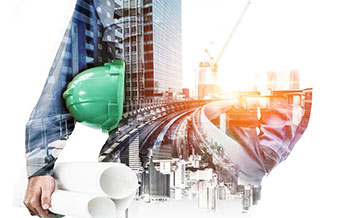
Why To Choose Warehouse Builders?
Learn More
Essential Blogs for the Construction Industry
Learn More
Pre-Engineered Building Future of Construction Industry
Learn MoreOur Construction Works
When you choose us, you'll feel the benefit of 20 years' experience of industrial construction services. With our capacity to meet the mass requests, we have had the option to take special care of the requirements of our significant clients.
Warehouse Construction
The most common material used for warehouses is steel, creating a pipe system that supports the outside cladding & roof.

Industrial Construction
Industrial construction deals with factories, power plants, warehouses, and other highly specialized facilities.

PEB
Manufacturers
Pre-Engineered Building is the fundamental based design which directly manufactured by the PEB Manufacturers association.

PEB
Contractors
PEB is the ideal choice for any kind of construction needs whether it is for the individual reason/for the business reason.

Pre-Engineering Building
Pre-Engineering Building are broadly utilized in the residential just as industrial sector for its unparalleled attributes.

PEB Steel
Building Construction
Steel is heat proof, meaning it will not totally stop a fire. Steel is one of the most durable materials for construction.

